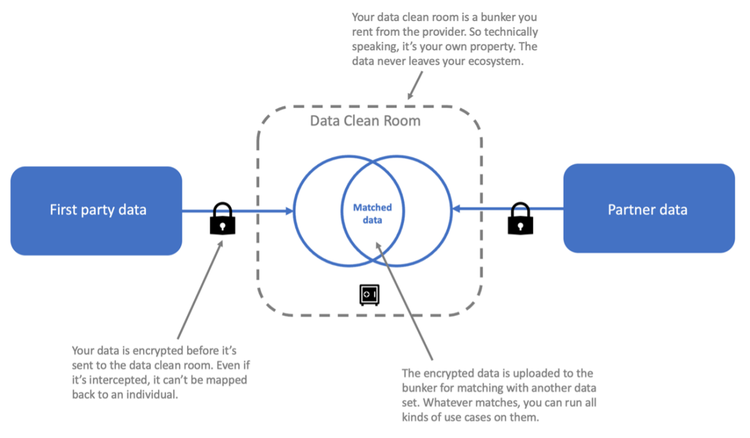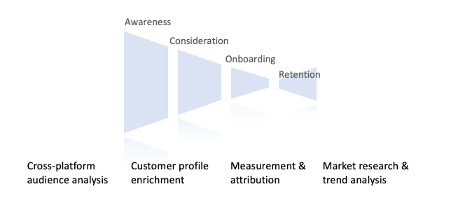Data Clean Rooms – The Next Big Thing or Just Another Hype Cycle?

In the world of data-driven marketing & analytics, new buzzwords and trends often emerge, promising revolutionary solutions to complex challenges. And we certainly have one today. Compliantly collecting customer data whilst using it effectively and at scale, is an oxymoron that many marketers secretly wish they didn’t have to deal with on a day-to-day basis.
Advocates of data clean rooms argue that this solution holds the potential to transform how organisations handle and leverage customer data. And I want to believe them. I can see the potential here, the way they use private bunkers and one-way encryptions is incredibly smart, but this article is going to try and objectively look at the whole picture and address the fact that with any emerging trend, including my beloved CDPs, there’s always a healthy dose of scepticism that orbits the ever-present question – is it feasible and/or scalable?
So together let’s explore data clean rooms, delving into their definition, benefits, challenges, and ultimately answer the question – are data clean rooms the next big thing or are we in just another hype cycle?
Understanding Data Clean Rooms
At their core, data clean rooms are highly secure environments where multiple parties, such as advertisers and data providers, can share and analyse data without compromising individual privacy. They provide a controlled and privacy-focused space where data can be combined, processed, and analysed while adhering to stringent privacy regulations.
Here’s a simplified process overview of how organisations will go about utilising a data cleanroom:

Now let’s have a look at the benefits of data clean rooms:
1. They’re super secure and privacy-first
Data clean rooms offer a heightened level of privacy protection, letting organizations combine data sets without exposing personally identifiable information (PII). By using advanced privacy-preserving techniques, clean rooms ensure that individual identities remain anonymized throughout the data analysis process.
2. You get better data quality and accuracy
Clean rooms provide a controlled environment that ensures data integrity, accuracy, and consistency. By enforcing rigorous data hygiene practices and standardised protocols, clean rooms help eliminate data discrepancies and improve the overall quality of insights derived from combined datasets.
3. It doesn’t require the user’s consent
This is a grey area so grab that salt shaker (a colloquial joke) - Data clean rooms operate within your own ecosystem, ensuring that data never leaves your secure environment. By working with aggregated and encrypted data, personal identifiers are removed, and individual records are anonymized, minimizing the risk of privacy breaches. Similar to Google’s Privacy Sandbox. As a result, organizations can leverage the insights gained from the clean room analysis without requiring explicit user consent for uploading and processing the data.
Next, let’s look at the challenges:
1. You need a lot of customer data
When intersecting encrypted PII data from a marketer and a publisher and neither have a particularly big data set, you run the risk of having a very small overlap. This is where the theory of a data clean room is great, but the reality is if there’s little overlap, there isn’t much scalability or statistical significance in the analysis you can do. Once both parties upload their data and that venn diagram see’s very little in the middle, then what? That’s a lot of work for very little actionable data.
2. You need to create a lot of data partnerships
Forming data partnerships with publishers, partners, and walled gardens can be a lot of work and a lot of red tape. One of the primary difficulties lies in establishing and managing these partnerships, as each entity may have its own data-sharing policies, technical requirements, and contractual agreements. Coordinating the integration of data from various sources, each with its own data formats and structures, can be complex and time-consuming.
3. The use cases aren’t always clear
The concept of data clean rooms and their potential use cases can often be shrouded in ambiguity, making it challenging for marketers to discern where they fit within their existing digital marketing strategies. While data clean rooms offer opportunities for collaboration and data analysis, their precise applications may not always be immediately clear.
I often think in terms of the age-old marketing funnel, and I also think in terms of touch points (display, social, CTV, website, call centre, email, SMS, push and app to name a few) and I can just about imagine where each data clean room use case could be applied within my beloved funnel, but those trusty arrows pointing to which part of the funnel they help, have not made it onto this diagram, because I’m not 100% sure.

Conclusion:
So, are data clean rooms the next big thing or just the next big hype? The answer lies in a balanced evaluation of their potential benefits and challenges. Data clean rooms offer a compelling solution for organizations with huge amounts of first-party data who are seeking to leverage that data in a very secure and privacy-compliant manner.
Their successful implementation also requires you to ask yourself three important questions:
1. Who are your strategic data partners (publishers, 2nd/3rd party etc) that will generate a big overlap with your own first-party data?
2. Of those, which ones are willing to go into a data partnership with your organisation and share the precious user attributes tied to profiles?
3. What’s their financial incentive to go through this very technical and legal-heavy process with you?
This isn’t supposed to act as a deterrent. It’s about asking these difficult questions upfront so you maximise your chances of success with this project. By conducting a thorough assessment of the technical feasibility, regulatory landscape, and collaboration dynamics, organisations can make an informed decision about whether data clean rooms are the right solution for their strategic roadmap.
Ultimately, data clean rooms have the potential to revolutionise how organisations unlock insights from data collaboration while respecting individual privacy. That in itself is a worthy reason to explore data clean rooms and see how much potential there is. Good luck.
Foto: Markus Spiske on Unsplash